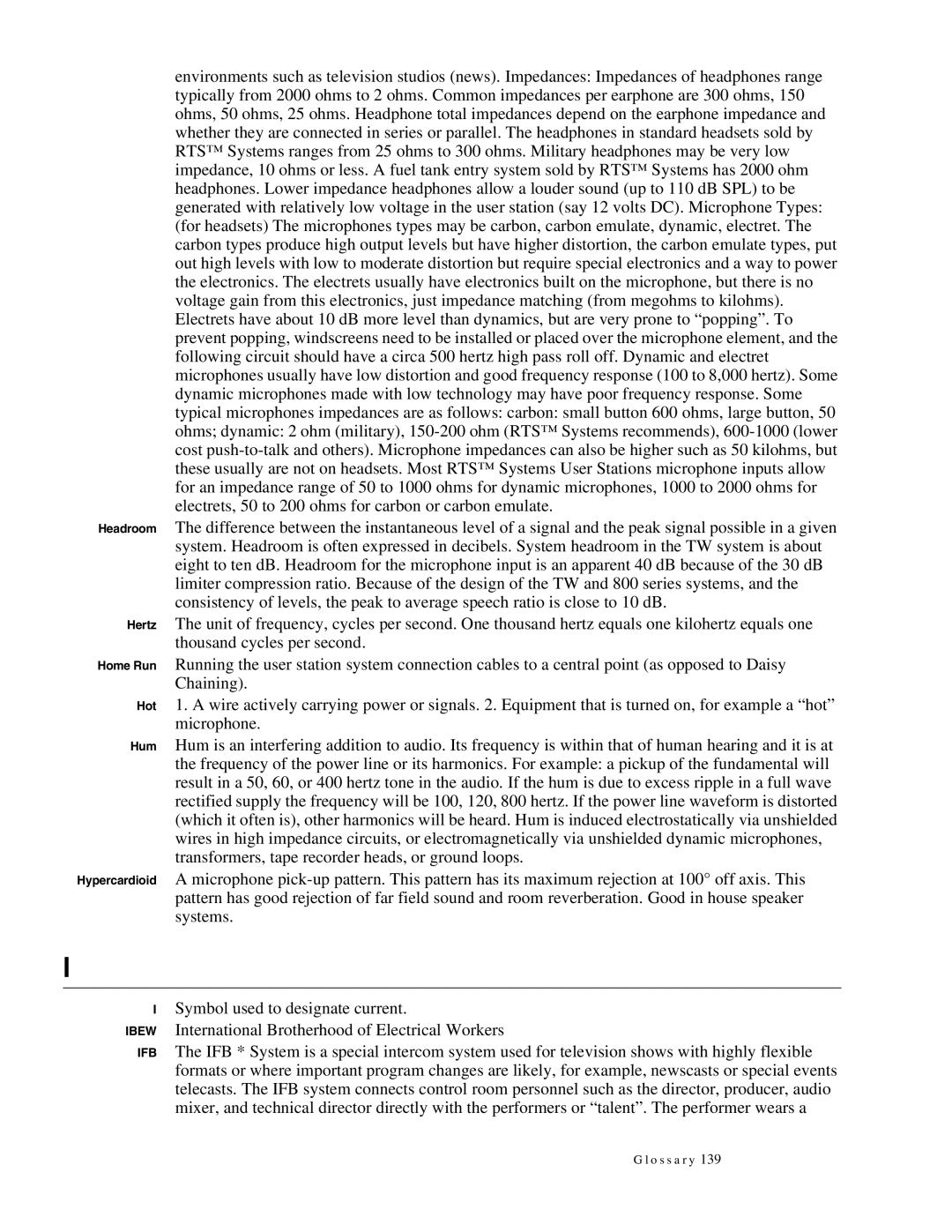Headroom
Hertz
Home Run
Hot
Hum
Hypercardioid
environments such as television studios (news). Impedances: Impedances of headphones range typically from 2000 ohms to 2 ohms. Common impedances per earphone are 300 ohms, 150 ohms, 50 ohms, 25 ohms. Headphone total impedances depend on the earphone impedance and whether they are connected in series or parallel. The headphones in standard headsets sold by RTS™ Systems ranges from 25 ohms to 300 ohms. Military headphones may be very low impedance, 10 ohms or less. A fuel tank entry system sold by RTS™ Systems has 2000 ohm headphones. Lower impedance headphones allow a louder sound (up to 110 dB SPL) to be generated with relatively low voltage in the user station (say 12 volts DC). Microphone Types: (for headsets) The microphones types may be carbon, carbon emulate, dynamic, electret. The carbon types produce high output levels but have higher distortion, the carbon emulate types, put out high levels with low to moderate distortion but require special electronics and a way to power the electronics. The electrets usually have electronics built on the microphone, but there is no voltage gain from this electronics, just impedance matching (from megohms to kilohms). Electrets have about 10 dB more level than dynamics, but are very prone to “popping”. To prevent popping, windscreens need to be installed or placed over the microphone element, and the following circuit should have a circa 500 hertz high pass roll off. Dynamic and electret microphones usually have low distortion and good frequency response (100 to 8,000 hertz). Some dynamic microphones made with low technology may have poor frequency response. Some typical microphones impedances are as follows: carbon: small button 600 ohms, large button, 50 ohms; dynamic: 2 ohm (military),
The difference between the instantaneous level of a signal and the peak signal possible in a given system. Headroom is often expressed in decibels. System headroom in the TW system is about eight to ten dB. Headroom for the microphone input is an apparent 40 dB because of the 30 dB limiter compression ratio. Because of the design of the TW and 800 series systems, and the consistency of levels, the peak to average speech ratio is close to 10 dB.
The unit of frequency, cycles per second. One thousand hertz equals one kilohertz equals one thousand cycles per second.
Running the user station system connection cables to a central point (as opposed to Daisy Chaining).
1.A wire actively carrying power or signals. 2. Equipment that is turned on, for example a “hot” microphone.
Hum is an interfering addition to audio. Its frequency is within that of human hearing and it is at the frequency of the power line or its harmonics. For example: a pickup of the fundamental will result in a 50, 60, or 400 hertz tone in the audio. If the hum is due to excess ripple in a full wave rectified supply the frequency will be 100, 120, 800 hertz. If the power line waveform is distorted (which it often is), other harmonics will be heard. Hum is induced electrostatically via unshielded wires in high impedance circuits, or electromagnetically via unshielded dynamic microphones, transformers, tape recorder heads, or ground loops.
A microphone
I
I IBEW IFB
Symbol used to designate current.
International Brotherhood of Electrical Workers
The IFB * System is a special intercom system used for television shows with highly flexible formats or where important program changes are likely, for example, newscasts or special events telecasts. The IFB system connects control room personnel such as the director, producer, audio mixer, and technical director directly with the performers or “talent”. The performer wears a
